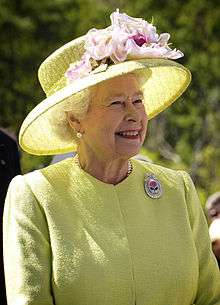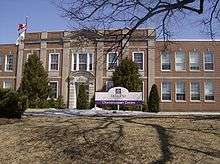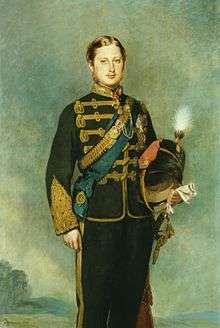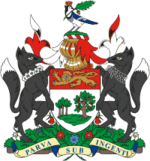Monarchy in Prince Edward Island
| Queen in Right of Prince Edward Island | |
|---|---|
|
Provincial/State | |
|
| |
| Incumbent | |
 | |
|
Elizabeth II Queen of Canada since 6 February 1952 | |
| Details | |
| Style | Her Majesty |
| First monarch | Victoria |
| Formation | 1 July 1873 |
| Residence | Government House, Charlottetown |
By the arrangements of the Canadian federation, the Canadian monarchy operates in Prince Edward Island as the core of the province's Westminster-style parliamentary democracy.[1] As such, the Crown within Prince Edward Island's jurisdiction is referred to as the Crown in Right of Prince Edward Island,[2] Her Majesty in Right of Prince Edward Island,[3] or the Queen in Right of Prince Edward Island.[4] The Constitution Act, 1867, however, leaves many royal duties in Prince Edward Island specifically assigned to the sovereign's viceroy, the Lieutenant Governor of Prince Edward Island,[1] whose direct participation in governance is limited by the conventional stipulations of constitutional monarchy.[5]
Constitutional monarchy in Prince Edward Island
The role of the Crown is both legal and practical; it functions in Prince Edward Island in the same way it does in all of Canada's other provinces, being the centre of a constitutional construct in which the institutions of government acting under the sovereign's authority share the power of the whole.[6] It is thus the foundation of the executive, legislative, and judicial branches of the province's government.[7] The Canadian monarch—since 6 February 1952, Queen Elizabeth II—is represented and her duties carried out by the Lieutenant Governor of Prince Edward Island, whose direct participation in governance is limited by the conventional stipulations of constitutional monarchy, with most related powers entrusted for exercise by the elected parliamentarians, the ministers of the Crown generally drawn from amongst them, and the judges and justices of the peace.[5] The Crown today primarily functions as a guarantor of continuous and stable governance and a nonpartisan safeguard against the abuse of power.[5][8][9] This arrangement began with an 1873 Order in Council by Queen Victoria and continued an unbroken line of monarchical government extending back to the early 16th century.[10] However, though Prince Edward Island has a separate government headed by the Queen, as a province, Prince Edward Island is not itself a kingdom.[11]
Government House in Charlottetown is owned by the sovereign in her capacity as Queen in Right of Prince Edward Island, and is used as an official residence oth by the lieutenant governor and the sovereign and other members of the Canadian Royal Family will reside there when in Prince Edward Island.
Royal associations
Those in the Royal Family perform ceremonial duties when on a tour of the province; the royal persons do not receive any personal income for their service, only the costs associated with the exercise of these obligations are funded by both the Canadian and Prince Edward Island Crowns in their respective councils.[12] Monuments around Prince Edward Island mark some of those visits, while others honour a royal personage or event; the royal persons do not receive any personal income for their service, only the costs associated with the exercise of these obligations are funded by both the Canadian and Prince Edward Islander Crowns in their respective councils.[12] Further, Prince Edward Island's monarchical status is illustrated by royal names applied regions, communities, schools, and buildings, many of which may also have a specific history with a member or members of the Royal Family; Prince Edward Island is itself named in honour of Prince Edward, Duke of Kent and Strathearn. Associations also exist between the Crown and many private organizations within the province; these may have been founded by a Royal Charter, received a royal prefix, and/or been honoured with the patronage of a member of the Royal Family. Examples include the Central Agricultural Society, which was under the patronage of Albert, Prince Consort after 1843.[13]
The main symbol of the monarchy is the sovereign herself, her image (in portrait or effigy) thus being used to signify government authority.[14] A royal cypher or crown may also illustrate the monarchy as the locus of authority, without referring to any specific monarch. Further, though the monarch does not form a part of the constitutions of Prince Edward Island's honours, they do stem from the Crown as the fount of honour, and so bear on the insignia symbols of the sovereign.
 The Kings County Playhouse in Georgetown, King's County, both of which are named in honour of King George III
The Kings County Playhouse in Georgetown, King's County, both of which are named in honour of King George III- Charlottetown, named for Queen Charlotte
 Prince of Wales College, which derived its name from Prince Edward, Prince of Wales (later King Edward VII)
Prince of Wales College, which derived its name from Prince Edward, Prince of Wales (later King Edward VII)
History

What is today Prince Edward Island was discovered and claimed by John Cabot for King Henry VII, though it was later, in 1523, also claimed by Giovanni da Verrazzano for King Francis I, putting Île Saint-Jean, as Verrazzno called it, under the sovereignty of the French Crown until 1758. In that year, the French settlement of Louisbourg (in present-day Nova Scotia) fell to the British Royal Navy and, with the 1762 Treaty of Fontainbleau, sovereignty over the island was officially transferred by King Louis XV to King George III.[15] In 1763, the Earl of Egmont presented an elaborate memorial to the King, asking that the Island of Saint John, while under the sovereignty of the Crown indefinitely, be granted to him and divided into baronies. George initially denied Egmont's request,[16] but, after Edgemont again presented his petition in 1767, the King this time approved. On 19 July 1769, Saint John Island was separated from the jurisdiction of Nova Scotia and became its own colony of the British Crown.[17]
Prince Edward, George III's fourth son, arrived in Halifax, Nova Scotia, in 1794 and, while he never visited Saint John Island, he, as Commander-in-Chief of the British forces in North America, ordered that new barracks be built in Charlottetown and defences constructed to protect the harbour.[18] Recognising the Prince's interest in the island, its legislature passed a bill on 1 February 1799 that changed the colony's name in honour of Edward.[19] By 1843 construction of Province House was begun, and the laying of the cornerstone was followed by a Royal Salute and three cheers for Queen Victoria.[20] Not four years later, the Legislative Assembly adopted an address to the Queen, asking for the establishment of responsible government in the colony, and the request was soon thereafter granted.[21]
Queen Elizabeth II attended the 100th anniversary of Prince Edward Island's entry into Confederation.
See also
References
- 1 2 Victoria (29 March 1867). "Constitution Act, 1867". III.9, V.58. Westminster: Queen's Printer. Retrieved 15 January 2009.
- ↑ Elizabeth II (1985). "Transboundary Pollution (Reciprocal Access) Act" (PDF). 7. Charlottetown: Queen's Printer for Prince Edward Island. Retrieved 11 July 2009.
- ↑ Elizabeth II (1985). "Prince Edward Island Science and Technology Corporation Act" (PDF). 2.7. Charlottetown: Queen's Printer for Prince Edward Island. Retrieved 11 July 2009.
- ↑ Department of Canadian Heritage (31 March 2006). "Official Languages > Canada-Prince Edward Island Agreement on French-Language Services 2005-06 to 2008-09". Queen's Printer for Canada. Retrieved 11 July 2009.
- 1 2 3 MacLeod, Kevin S. (2008). A Crown of Maples (PDF) (1 ed.). Ottawa: Queen's Printer for Canada. p. 16. ISBN 978-0-662-46012-1.
- ↑ Cox, Noel (September 2002). "Black v Chrétien: Suing a Minister of the Crown for Abuse of Power, Misfeasance in Public Office and Negligence". Murdoch University Electronic Journal of Law. Perth: Murdoch University. 9 (3): 12. Retrieved 17 May 2009.
- ↑ Privy Council Office (2008). Accountable Government: A Guide for Ministers and Ministers of State – 2008. Ottawa: Queen's Printer for Canada. p. 49. ISBN 978-1-100-11096-7. Retrieved 17 May 2009.
- ↑ Roberts, Edward (2009). "Ensuring Constitutional Wisdom During Unconventional Times" (PDF). Canadian Parliamentary Review. Ottawa: Commonwealth Parliamentary Association. 23 (1): 15. Retrieved 21 May 2009.
- ↑ MacLeod 2008, p. 20
- ↑ Victoria (26 June 1873). "Prince Edward Island Terms of Union". Schedule. Westminster: Queen's Printer. Retrieved 16 June 2009.
- ↑ Forsey, Eugene (31 December 1974). "Crown and Cabinet". In Forsey, Eugene. Freedom and Order: Collected Essays. Toronto: McClelland & Stewart Ltd. ISBN 978-0-7710-9773-7.
- 1 2 Palmer, Sean; Aimers, John (2002), The Cost of Canada's Constitutional Monarchy: $1.10 per Canadian (2 ed.), Toronto: Monarchist League of Canada, archived from the original on 19 June 2008, retrieved 15 May 2009
- ↑ Campbell, Duncan (1875). History of Prince Edward Island. Charlottetown: Bremner Brothers. p. 98. Retrieved 11 July 2009.
- ↑ MacKinnon, Frank (1976), The Crown in Canada, Calgary: Glenbow-Alberta Institute, p. 69, ISBN 978-0-7712-1016-7
- ↑ Campbell 1875, p. 2
- ↑ Campbell 1875, pp. 10–11
- ↑ Campbell 1875, p. 19
- ↑ Campbell 1875, p. 54
- ↑ Campbell 1875, p. 56
- ↑ Campbell 1875, p. 97
- ↑ Campbell 1875, p. 101
External links
- "Prince Edward visits his island". The Guardian. 12 October 2007.
- "Royal couple wraps up trip to Prince Edward Island". CBC. 10 November 2000.
